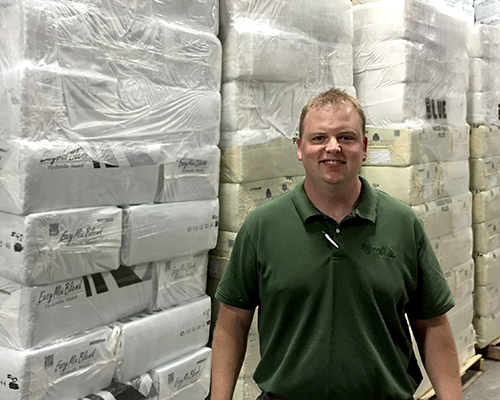Tomahawk Indiangrass
CONSERVATION NATIVE GRASSES
At Rivard’s Turf & Forage, we offer a complete and extensive selection of native seed and introduced seed species and varieties for reclamation, erosion control, mining, wetland, riparian, forestry and wildlife habitat. We custom blend and mix to meet Conservation Reserve Program (CRP) seed, utility right-of-way, DOT and mining reclamation seed specs.
Rivard’s Turf & Forage is your source for ecologically appropriate and environmentally sound grass, forb, legume, shrub and wildflower seed. View our Conservation, Reclamation and Native seed varieties or contact us for more information.
Please contact us to get a specific quote on your custom mix.
NATIVE GRASSES
| Grasses | Rate/Ac. PLS# | Height | Season |
|---|---|---|---|
| Big Bluestem | 8-12 | 4′-6′ | Warm |
| Blue Grama | 3-5 | 1′-2′ | Warm |
| Bufallograss | 8-26 | 3″-8″ | Warm |
| Canada Bluegrass | 1-2 | 1′-2′ | Cool |
| Canada Wildrye | 8-10 | 4′-5′ | Cool |
| Fowl Bluegrass | 1-2 | 2′-3.5′ | Cool |
| Green Needlegrass | 8-10 | 1.5′-3′ | Cool |
| Indiangrass | 8-10 | 4′-6′ | Warm |
| Little Bluestem | 6-8 | 2.5′-3′ | Warm |
| Needle-and-Thread Grass | 8-10 | 1.5′-3′ | Cool |
| Prairie Cordgrass | 8-10 | 3′-8′ | Warm |
| Prairie Dropseed | 3-4 | 2′-3′ | Warm |
| Prairie Junegrass | 1-2 | .5′-2′ | Cool |
| Prairie Sandreed | 6-8 | 3′-5′ | Warm |
| Sand Dropseed | .5-1 | 1′-3′ | Warm |
| Sideoats Grama | 8-10 | 1′-3′ | Warm |
| Switchgrass | 5-8 | 3′-5′ | Warm |
| Virginia Wildrye | 10-15 | 3′-4′ | Cool |
| Wheatgrass, Intermediate | 10-12 | 3′-4′ | Cool |
| Wheatgrass, Slender | 10-12 | 2′-2.5′ | Cool |
| Wheatgrass, Thickspike | 10-12 | 1′-3′ | Cool |
| Wheatgrass, Tall | 10-12 | 3′-7′ | Cool |
| Wheatgrass, Western | 10-12 | 1′-3′ | Cool |
| Wildflowers | Rate/Ac. PLS# | Height | Color |
|---|---|---|---|
| Black-Eyed Susan | 1-2 | 1′-3′ | Yellow |
| Blanket Flower | 5-7 | 1′-1.5′ | Red/Yellow |
| Blue Flax | 5-7 | 1.5′-2.5′ | Blue |
| Blue Vervain | 1-2 | 1′-6′ | Blue |
| Canada Milkvetch | 6-8 | 1′-3′ | Cream |
| Coneflower, Purple | 10-15 | 3′-4′ | Purple |
| Coneflower, Yellow | 2-5 | 2′-3′ | Yellow |
| False (Ox-Eye) Sunflower | 15-20 | 3′-4′ | Yellow |
| False Boneset | 1-2 | 1′-4′ | Cream |
| Four-Wing Saltbush | 5-8 | 2′-3′ | Yellow |
| Illinois Bundleflower | 15-20 | 3′-4′ | White |
| Lead Plant | 6-8 | 1′-3′ | Purple |
| Maximillian Sunflower | 5-6 | 3′-7′ | Yellow |
| Partridge Pea | 20-25 | 1′-3′ | Yellow |
| Plains Coreopsis | 8-10 | 1′-3′ | Yellow |
| Prairie Blazingstar | 8-10 | 2′-3′ | Purple |
| Prairie Cinquefoil | .5-1 | 1′-3′ | Yellow |
| Purple Prairie Clover | 3-5 | 1′-3′ | Purple |
| Shell-Leaf Penstemon | 5-8 | 1.5′-2′ | Lavender |
| Stiff Goldenrod | 1-2 | 1′-5′ | Yellow |
| Stiff Sundflower | 10-15 | 2.5′-6′ | Yellow |
| White Prarie Clover | 3-5 | 1′-3′ | White |
| Wild Bergamot | 1-2 | 2′-4′ | Lavender |
| Yarrow | .5-1 | 2′-3′ | White |
NATIVE PRAIRIE
Purple Prairie Clover
ESTABLISHING A NATIVE PRAIRIE
1. Clear Site Of All Debris
By mowing, cultivating, or burning. A chemical application (glyphosate) might help as well. You want to make sure your seed has as little competition as possible.
2. Prepare A Firm Seedbed
Make sure, after cultivating 4-6″ deep, that the ground is firmly packed with a harrow or packer-wheel. This insures that the seed will be sown at a consistent depth and that it will not dry out.
3. Buy Quality Seed
It is very important to make sure that you are using the best quality seed available. Good seed insures that you will not have a problem with the flowability through your planter or spreader, making for consistent seed coverage. When you buy Rivard’s seed products, your are guaranteed to get the highest quality seed available with unsurpassed vigor.
4. Plant Seed According To Specs
If you are drill-seeding, most natives require a seeding depth of no more than 1/3″ deep. If you are broadcasting, we recommend at least 1.5 times the drill rate. Both practices should be followed with a light harrow or packer-wheel. To be sure of seeding specifications, check with your local NRCS office.
5. Control Weeds
Mowing or spot spraying with a chemical application can reduce weed competition. We have seen the best results of native seed stands by mowing (6-8″) several times a year until established. Applying a chemical application will work, but most broad leaf grass chemicals will kill the forbs and wildflowers in your seed mix. The key is to mow before the weed heads seed out, and patience. A quality prairie may take between 2-4 years to establish, and you will see your planting develop into the prairie you envisioned.


If you have questions or would like additional information regarding Conservation Native Grasses, please contact: Ross Rivard Vice-President Forage & Native Seed Specialist Phone: 800-731-5765 Cell: 701-330-3699 ross@rivards.com Grand Forks, ND
